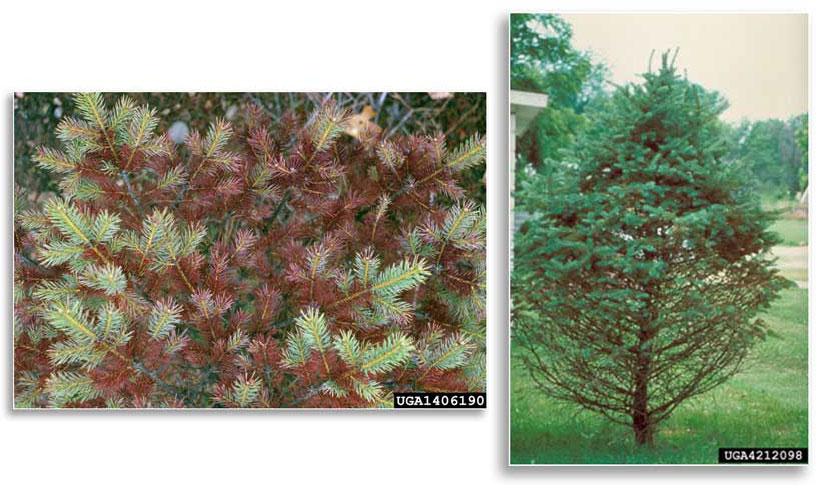Plant Health: Skimpy Spruce - Defoliation from the Bottom Up
By Nicole Ward Gauthier & Kimberly Leonberger
Rhizosphaera needle cast, the most common disease of spruce in Kentucky, causes needle drop on lower branches, resulting in a distinct thinned appearance. The fungal pathogen, Rhizosphaera kalkhoffii, primarily infects spruce but can also affect some pine species. 
Symptoms:
- Become evident in summer when needles on lower branches turn purplish or brown.
- Needles fall within a few weeks and lower limbs are left bare.
- Small, dark fruiting bodies (called pycnidia) form in stomata (pores in needles) and can be used to confirm diagnoses (Photos 3 & 4). Pycnidia are most easily recognized with a hand lens, but are also visible with the naked eye.
Life cycle:
The life cycle of the fungus extends over a 15-month period. Initial infection typically takes place in spring when spores (conidia) within pycnidia are rain splashed from needle debris onto foliage. Infection can continue as long as moisture is present. During winter or the following spring, pycnidia develop in infected needles, plugging stomata. Needle discoloration and needle drop occur during summer of the second season, resulting in thinning of lower canopies. If defoliation occurs 3 to 4 consecutive years, branch death is likely.

Disease management:
- Stressed trees are more susceptible to infection by R. kalkhoffii than healthy plants, so steps should be taken to maintain plant vigor.
- Properly space plants to improve air circulation.
- Practice good sanitation habits. For additional information see the Landscape Sanitation publication.
- Homeowners can apply fungicides that contain chlorothalonil, copper, or mancozeb during needle emergence (mid-April). During rainy seasons or in plantings with a history of disease, fungicides may be applied two consecutive years during spring when fungi are most active. For more information, see Homeowner’s Guide to Fungicides.
Photography
- Needles infected with Rhizosphaera turn purplish brown during summer. (USDA Forest Service Archive, USDA Forest Service, Bugwood.org)
-
Needle drop and thinning of lower canopy are classic symptoms of Rhizosphaera needle cast in spruce. (Minnesota Department of Natural Resources Archive, Minnesota Department of Natural Resources, Bugwood.org)
- Fungal pycnidia are often visible without a hand lens. (Paul Bachi, University of Kentucky)
- Fungal pycnidia protrude from stomata. (Paul Bachi, University of Kentucky)
About the Authors
Dr. Nicole Ward Gauthier is an Extension Associate Professor in the University of Kentucky Department of Plant Pathology. Her focus includes diseases of ornamentals (landscape, nursery and greenhouse) and fruit crops. Email at nicole.ward@uky.edu
Kimberly Leonberger is an Agriculture Extension Associate in the University of Kentucky Department of Plant Pathology. Email at kimberly.leonberger@uky.edu
